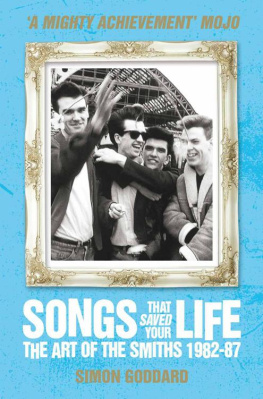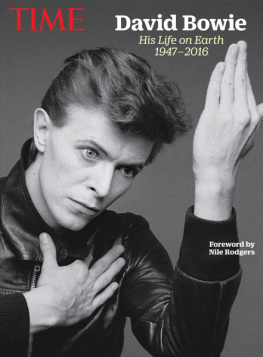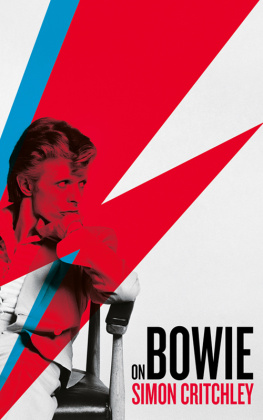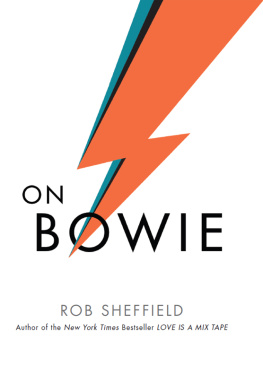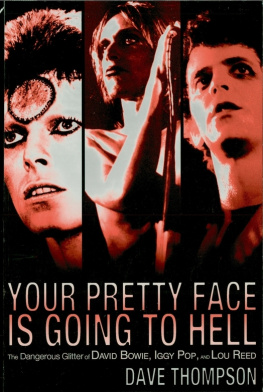CONTENTS
About the Book
He came from Outer Space
It was the greatest invention in the history of pop music the rock god who came from the stars which struck a young David Bowie like a lightning bolt from the heavens.
When Ziggy the glam alien messiah fell to Earth, he transformed Bowie from a prodigy to a superstar who changed the face of music forever. But who was Ziggy Stardust? And where did he really come from?
In a work of supreme pop archaeology, Simon Goddard unearths every influence that brought Ziggy to life from HG Wells to Holst, Kabuki to Kubrick, and Elvis to Iggy. Ziggyology documents the epic drama of the Starmans short but eventful time on Planet Earth and why Bowie eventually had to kill him.
About the Author
Simon Goddard is a freelance UK music journalist whose work has appeared in, amongst others, Q magazine, Uncut and the Independent On Sunday. He is best known for his two previous books on The Smiths and their former lead singer Morrissey. His first, Songs That Saved Your Life, was named the best Smiths book by the Guardian and was followed up by the critically acclaimed Mozipedia The Encyclopedia Of Morrissey and The Smiths. He lives in London.
For Spike Reeve-Daniels.
A Starman is born.
PREFACE
THIS IS A book about Ziggy Stardust, the alien pop star who inhabited the mind, voice and trousers of David Bowie from, roughly, late 1971 until his death on stage at the Hammersmith Odeon on 3 July 1973.
It is the story of how Ziggy entered Bowies head and what happened once he got there.
It is the story of how long it took human civilisation to arrive at the concept of Ziggy Stardust and how short it took for one human to do his bidding before resorting to suicide.
This book is mostly the story of Ziggy Stardust but only sometimes the story of David Bowie.
All events, places and characters in this book are based on factual documentary evidence and eyewitness testimony.
This book was written out of love
For Ziggy, Ronno, Weird and Gilly.
For art and outer space.
For glamour and rock n roll.
For youth and hope.
For glitter and nail paint.
And for all those who, like its author, choose to live looking up at the stars.
Simon Goddard
Telephone kiosk 0207 734 8719
London
PROLOGUE
THE EVE OF NO MORE
Since the dawn of time over 100 billion human beings have walked on this planet.
Now, 100 billion is about the number of stars in our Milky Way galaxy. This means that for everyone whos ever lived there could be a star.
Stars are suns with planets circling around them. So isnt it an interesting thought that theres enough land in the sky for everyone to have a whole world?
We dont know how many of those worlds are inhabited, or by what kinds of creatures, but one day we should know. Perhaps by radio. Perhaps by other means. Perhaps by contact.
The impact of that on the human race will be profound.
ARTHUR C. CLARKE
TO ANY EYES of any creatures on any worlds that might be peering across the gulf of space to the planet Earth, it is a Tuesday just like any other Tuesday. So named by Englands Nordic ancestors after their god of war, Tiw. Or as the Romans called him, Mars.
Just another day of Mars in the city of London. Mankind swarming to and fro in its infinite complacency. Sweetly oblivious to any remote yet penetrating interstellar gaze. Blissfully unaware that anyone or anything out there in the endless outreach of space might be tuning in, trying to decipher and decode the strange signals of human life. That their words, phrases, songs, sounds, wild halloo and brutal noise could be echoing through the cosmos towards alien ears in a random transmission of exotic gibberish. Of work-to-rule, IRA, strip-kings, picket lines, Double Diamond, Nimble, Mark Phillips and Princess Anne. Of upstairs, downstairs, Watergate, Follyfoot, Fenn Street, Colditz and Honey, can the can. Of Hawkeye, Hot Lips, Bobby Crush, Elephant Boy, Edward Heath, Idi Amin and Dave Allen At Large. Of Skweeze me!, Its frothy, man, Stay on the bus, forget about us, Wombling free, Nice one, Cyril and Is there life on Mars?
As the planet spins the sun shines high and bright over London, hitting 25 degrees as the clock tightly ticks towards noon. Our focus drifts south, to the edge of the city in the suburb of Bromley, through the streets where H. G. Wells once scampered with youthful dreams of mankinds annihilation. On the lawn outside Princes Plain School for Girls there is a deathly hush of anxiety. Detective Superintendent Alan Jones and his softly, softly squad are gently prodding their fingers of suspicion at the teenage pupils. Jones believes one of them may be responsible for the kidnap of a seven-week-old baby girl from her mothers pram; the child was later discovered alive, just, covered in flies and maggots at the foot of an oak tree in nearby woodland and is now fighting for her life in hospital. Such is the cruel nature of crime on this day of Mars: of headless torsos found half buried in mudbanks; of car bombs and hunger strikes; of babies freely snatched from unattended prams to be found in clumps like unpicked daisies on every high street.
A jolt north to Catford, home of the baby girls mother, where an all elbows and Instamatic-camera rabble gather around the entrance of a new supermarket to see a 45-year-old TV star cut the ribbon. Its the biggest crowd Ive ever seen! declares Bruce Forsyth, tossing apples and comic books at boggle-eyed children as the Band of Life Guards skirl into activity encouraged by the baton twirls of comic mascot Major Saver. Those who dont immediately encircle Forsyth in a jig of waving pens soon set the tills ringing with Koo marmalade, Chiltonian biscuits and the impulsive extravagance of some Hirondelle table wine; praying the latters reward of a fuzzy head and double Green Shield stamps will justify the havoc wreaked upon that weeks housekeeping. Others peruse the home-furnishings department with childish wonder, staring with impoverished sadness at their moping convex reflection in a Swan Regal kettle or stroking covetous paws across the scientific miracle that is the Goblin Teasmade. Such is the substance of material dreams on this day of Mars: of Servis Supertwins, of Vymura wallpaper, of Wyclox Moonbeams.
Our attention is grabbed by fresh hysteria now echoing from the grassy courts of Wimbledons All England Lawn Tennis & Croquet Club. Today, in what is being billed as the Battle of the Heartthrobs, quarter-final war is being raged with ball and racket between national pride Roger Taylor and a formidable 17-year-old string-bean Viking named Bjorn Borg. Taylor is this years number-three favourite; formerly sixteenth until a mass boycott by players in support of controversially suspended Yugoslavian Niki Pilic greatly exaggerated his odds. Taylor sweats and puffs to match victory but is unable to prevent the stands quaking with the contagious aftershock of his opponents oestrogen-boiling beauty. A girl from Bromley is canvassed for her opinion by a reporter outside the grounds. When I see Borg, she sighs, wilting in the afternoon heat, I think, WOW! Such are the simply stirred loins on this day of Mars: by shining knights of Cassidy and Osmond, by fair maid Susans Lloyd and Stranks.
Evening approaches. A scorched scent hangs in the air over Battersea Pleasure Gardens, still smouldering after this mornings inferno when dolphins Flipper and Bubbles only just avoided being poached alive in their pool. Across the river, in the heart of the city, work-weary drones snatch the evening paper from peachy-cheeked vendors before scampering underground, squishing their fraying tempers together in smoky cylinders to digest it in silent contortion, grateful for whatever mental diversion from bodily discomfort it can bring. Actress Betty Grable, cultivator of a pair of legs magnificent enough to be insured for $1 million by Lloyds of London, has died of cancer, aged 56. And in Oxford, a teenage boy has been jailed indefinitely for an unprovoked attack on a meths-drinking Irish tramp whom he robbed of 1 pence after beating to death with a brick. The boys defence blames the influence of the recent film
Next page


